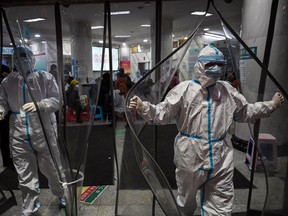How China shut down all attempts to find the origins of COVID-19 and now it may be too late
The Chinese government froze meaningful domestic and international efforts to trace the virus from the first weeks of the outbreak, and that continues to this day
BEIJING — The hunt for the origins of COVID-19 has gone dark in China, the victim of political infighting after a series of stalled and thwarted attempts to find the source of the virus that killed millions and paralyzed the world for months.
Go To Link For Video
The Chinese government froze meaningful domestic and international efforts to trace the virus from the first weeks of the outbreak, despite statements supporting open scientific inquiry, an Associated Press investigation found. That pattern continues to this day, with labs closed, collaborations shattered, foreign scientists forced out and Chinese researchers barred from leaving the country.
The investigation drew on thousands of pages of undisclosed emails and documents and dozens of interviews that showed the freeze began far earlier than previously known and involved political and scientific infighting in China as much as international finger-pointing.
As early as Jan. 6, 2020, health officials in Beijing closed the lab of a Chinese scientist who sequenced the virus and barred researchers from working with him.
Scientists warn the willful blindness over coronavirus’ origins leaves the world vulnerable to another outbreak, potentially undermining pandemic treaty talks coordinated by the World Health Organization set to culminate in May.
At the heart of the question is whether the virus jumped from an animal or came from a laboratory accident. A U.S. intelligence analysis says there is insufficient evidence to prove either theory, but the debate has further tainted relations between the U.S. and China.
Unlike in the U.S., there is virtually no public debate in China about whether the virus came from nature or from a lab leak. In fact, there is little public discussion at all about the source of the disease, first detected in the central city of Wuhan.
Crucial initial efforts were hampered by bureaucrats in Wuhan trying to avoid blame who misled the central government; the central government, which muzzled Chinese scientists and subjected visiting WHO officials to stage-managed tours; and the UN health agency itself, which may have compromised early opportunities to gather critical information in hopes that by placating China, scientists could gain more access, according to internal materials obtained by AP.
In a faxed statement, China’s Foreign Ministry defended China’s handling of research into the origins, saying the country is open and transparent, shared data and research, and “made the greatest contribution to global origins research.” The National Health Commission, China’s top medical authority, said the country “invested huge manpower, material and financial resources” and “has not stopped looking for the origins of the coronavirus.”

It could have played out differently, as shown by the outbreak of SARS, a genetic relative of COVID-19, nearly 20 years ago. China initially hid infections then, but WHO complained swiftly and publicly. Ultimately, Beijing fired officials and made reforms. The UN agency soon found SARS likely jumped to humans from civet cats in southern China and international scientists later collaborated with their Chinese counterparts to pin down bats as SARS’ natural reservoir.





Post a Comment